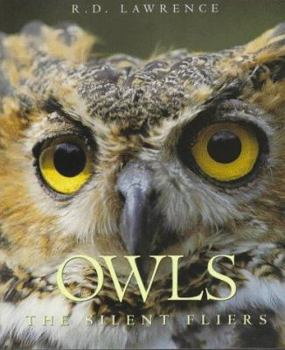Owls: The Silent Flyers
Select Format
Select Condition 
Book Overview
For centuries, owls have held an extraordinary fascination for people. Since Roman times, they have both been persecuted as harbingers of death and treasured as the embodiment of good fortune. Even... This description may be from another edition of this product.
Format:Hardcover
Language:English
ISBN:1552091465
ISBN13:9781552091463
Release Date:March 2001
Publisher:Firefly Books
Length:176 Pages
Weight:1.80 lbs.
Dimensions:0.7" x 8.4" x 10.3"
Customer Reviews
2 ratings
Lovely book
Published by Thriftbooks.com User , 18 years ago
You will love the many breathtaking color photographs in this book. The text is comprised largely of personal accounts of encounters with various (mostly rehabilitated) owls, which is highly engaging and well written. Only the "forward" of the book discusses generic owl anatomy/behavior (rather quickly), the other chapters being species-specific stories of owl encounters. If you're looking for a good scientific reference, I'd consider "North American Owls" as a great addition. In fact, a few statements in this book seem questionable. The author describes how owls can catch prey in complete darkeness, and despite their extraordinarily sophisticated 2D hearing ability, he suspects that their sense of *smell* is key. This flies in the face of most research I've read. Experiments show that when an ear is plugged, or the ruff feathers are removed, the owl dramtically loses ability to locate prey. Hearing seems to be key. Most birds have really lousy sense of smell. He also says that nocturnal owls are somewhat handicapped by daylight, whereas all references I've read dispute this, saying owls are no more troubled by sunshine than we are (i.e., some occasional squinting), and my own experience photographing live owls with flash guns supports this. Also, he says owls lack a crop and gizzard. Everything I read says they have a "glandular" adaptation of the crop, and indeed have a gizzard, which is what forms the well-known pellets. So if you're looking for a good scientific reference, you might add another book, but nevertheless I cherish this book for its heartfelt personal stories about owls and it's gorgeous photographs. Nevertheless,
Silent death...
Published by Thriftbooks.com User , 23 years ago
...for rats, mice, possum and other small nocturnal animals. Delivered by the talons of one of the 19 species of North American owls described, and beautifully photographed in OWLS: THE SILENT FLYERS. The history of owl's relationship with man is mixed. Due to their nightly stealth and effectiveness as hunters many cultures have imbued them with special powers. As such they have oftentimes been persecuted as harbingers of death. Yet man also treasures these magnificent birds and in many places they are symbols of wisdom and good fortune. All this and much more is mentioned by the author as he tells of his personal experiences with many of the species through rehabilitating orphaned and injured birds. Diversity abounds. There are large species such as the Great Horned Owl and the Great Gray Owl and the tiny ones - Pygmy and Elf Owls. Ground dwellers such as the Burrowing Owl can be contrasted with northern-forest dwellers. Some have adapted to man made environments (the Barn Owl) while others are restricted to the remote artic wilderness (the Snowy Owl) Each chapter covers a different species or group of owls and each description is supplemented with a map showing range and useful information such as the birds measurements, description of its eggs, nesting and breeding behavior, their diet and lastly, but by no means least - owl-watching tips for birders. This is however not a field guide. For one thing, it's too large. It is a good general introduction to North American owls highlighted with 70 full color photos and written by someone who obviously appreciates these unique birds. It also remains one of the better books available on the subject.






